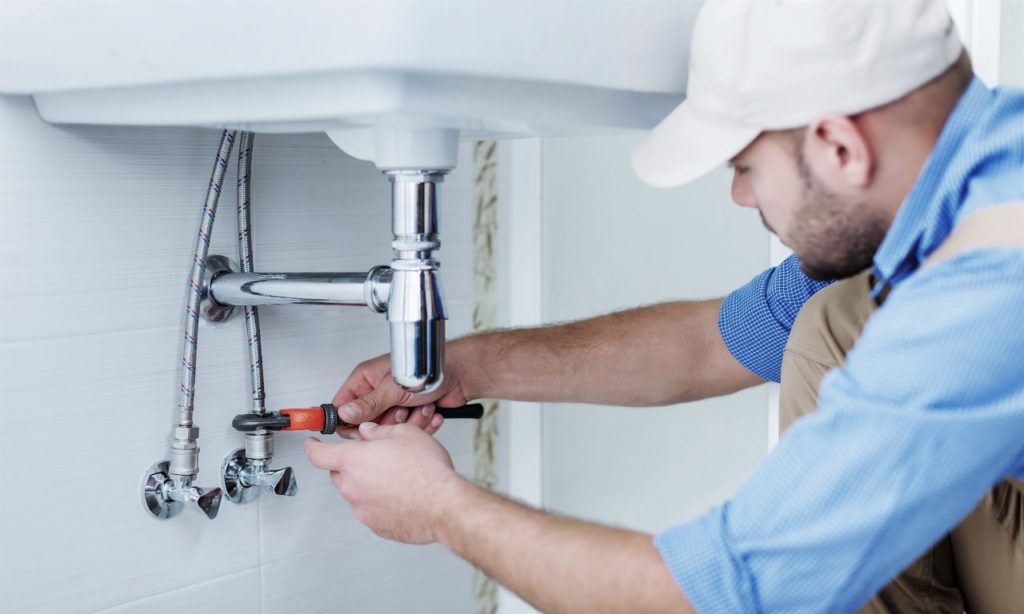Starting a new plumbing business can be a rewarding endeavor. The plumbing industry has erupted into a $107 billion industry and accounts for 600,000 jobs across the United States. These astounding figures make it a prime opportunity to strike out on your own and launch your very own business.
Even if you’ve been a professional plumber for years, you might be unsure about how to start your own plumbing business. Use this guide to learn everything that goes into starting your plumbing business.
8 steps to starting a plumbing business

Starting your own plumbing business will require training, a good amount of planning, and basic marketing strategies. Here are eight steps to launch a successful plumbing business.
1. Get plumbing licenses and certifications
Before you launch your own plumbing company in the United States, you’re legally required to have the appropriate certifications and licenses.
Each state has specific requirements to become a licensed plumber, but for the most part, the process is the same across the board. You’ll need to get certified, join an apprenticeship, take a licensing exam, and then become a Master Plumber.
Get a certification
After receiving your high school diploma or GED, you can enroll in a plumber certification program at a local college or trade school. These programs typically last two years and involve both in-class and hands-on training. You’ll learn how to use plumbing equipment, plumbing systems, and how to troubleshoot a variety of plumbing issues.
Become an apprentice
As an apprentice, you’ll be paid to receive on-the-job training from a Master Plumber. A Master Plumber is a highly experienced professional who is well-versed in all aspects of the plumbing industry. During this time, you’ll be able to network with other professional plumbers and learn everything you’ll need to know to become a Master Plumber.
Apprenticeships can take anywhere from two to five years to complete and will prepare you for your plumbing license exam.
Take your plumbing license exam
Once you’ve completed your apprenticeship, you’re ready to take your license exam. Each state has its own licensing requirements for its license exam.
In some states, you’ll need to renew your license periodically to remain eligible to offer your services to customers. You can find state-specific licensing requirements in this licensing guide.
After you’ve passed your exam, you can legally start working as a plumbing journeyman or start your own small business.
Become a Master Plumber
Being a Master Plumber is the highest distinction you can achieve in the plumbing industry. This process can take upwards of five years of on-the-job training and additional certifications.
Becoming a Master Plumber isn’t a requirement for starting your own business in some states, but it will set you apart from your competitors. It can also open more doors for you since you’ll have extensive experience and training that may help earn larger contracts.
2. Choose a plumbing business name
Your plumbing business name should be unique, memorable, and professional. It should clearly define what type of services you offer, with nothing left open for interpretation.
For example, a name like “Peterson Plumbing Services” states what type of service you provide and also gives a personal touch. On the other hand, a name like “United Solutions” is quite generic and doesn’t clearly explain what you offer.
It’s also a good idea to do a quick online search to see if you can reserve a website domain name. You can check to see if the domain is available on sites like GoDaddy or Name. Domain names are typically less than $20 per year. Once you purchase your domain name, you’re able to use it freely when you build your website, which we’ll cover in further detail below.
3. Register your plumbing business
You have three options when it comes to registering your business entity—a sole proprietorship, partnership, or limited liability company (LLC). Since you’ll be dealing with clients’ property, it’s best to choose an LLC, rather than a sole proprietorship or partnership.
Limited liability companies combine the best benefits of sole proprietorships, partnerships, and corporations. They offer pass-through taxation and protect your personal assets in the event of financial burdens or legal action.
Pass-through taxation means your income will only be taxed once on your personal tax return, rather than on both your personal and business tax return.
Limited liability means your personal assets will be protected if your company goes bankrupt or if a client or employee sues you for something like damaged property or injuries sustained on the job.
Each state has its own requirements and fees to become an LLC. The easiest way to find out your state’s requirements is to visit the Small Business Administration (SBA) website. From there, you can fill out all the necessary paperwork and be on your way to starting your plumbing business.
4. Decide which plumbing services you’ll offer
It’s good practice to focus on the services you’re most qualified to offer when you’re starting your plumbing company. Pick a few services and carve out your niche within your local area to increase your chances of success. This will ensure you’re able to offer the best service possible and keep all of your customers happy.
You can focus primarily on services like general plumbing repairs, leak detection, water heaters, garbage disposals, or sewer lines. You can also decide to focus on residential or commercial accounts or both, as long as you have the ability and workforce to adequately serve residential and commercial clients.
Once you’ve built up a client list and are running on full cylinders, you can expand your business into new areas and offer additional specialties.
5. Build a plumbing website
A professional-looking website is perhaps the most important marketing tool for your plumbing business. Most of your marketing channels will direct potential customers to your website.
Your website’s home page should have an attractive design and include a unique value proposition that tells customers how you can solve their plumbing issues. You can come up with a tagline like, “Don’t let water damage get you down. We’ll fix your leaks at a fraction of the cost.” You can then follow this up with a call to action, like “Reserve services now” and link to your phone number.
Keep your site simple, but make sure to include the following sections:
- Services offered
- Service areas
- About your company
- Testimonials
- Contact information
There’s a range of website builders you can use to design a website on your own, including Wix, Squarespace, and WordPress. These website builders are easy to use and have ready-made templates you can use to build your site.
6. Claim your Yelp Business Page
More than 90% of people use consumer reviews to determine the quality of local businesses. It’s critical you offer customers a way to leave reviews from the very start of your business.
Claiming your Yelp Business Page is one way to expand your online presence and build your collection of customer reviews.
Your Yelp Business Page gives potential customers a way to find your business online, read your business description, and find your contact details. They can also read reviews from other customers and determine if they want to do business with you based on your previous plumbing jobs.
As a business owner, you’re able to respond to customer reviews—both positive and negative—and display high-quality customer service on your Yelp Page. Potential customers receive a first-hand look into the level of service you provide and how you interact with previous customers.
7. Price your plumbing services
One of the most challenging aspects of starting your plumbing business will be pricing your services appropriately. It might be hard to do when first starting out, but there’s an easy way to choose the right pricing strategy.
Cost-plus pricing, also known as markup pricing, consists of adding up your daily overhead costs and setting your prices higher by your desired percentage. It’s the perfect option for a plumbing service business.
For example, let’s say you add up your operating costs for a job—like materials, fuel, and employee wages—and it amounts to $100. You then decide how much you want to mark up your services, which could be 50%. You would then set your service prices at $150 for the job.
8. Find your first customers
There are endless marketing strategies you can use when launching your plumbing business. Word of mouth, referrals, and social media are great ways to land your first new customers.
Tapping into your pre-existing networks, like your friends and family, can earn your first few accounts. Word-of-mouth marketing builds brand awareness in your area and it’s free.
Creating a referral program can also encourage current clients to recommend your business to others. You can offer current clients a 15% discount on future services for referring other customers your way. You can also give new clients a 15% discount on their first service.
Social media channels can boost your online presence and expand your customer base. For example, creating a Facebook page gives you a place to interact with current and potential customers and advertise promotions, discounts, and periodic updates.
For additional marketing ideas, look through our guide to different types of digital advertising to grow your business.
Turn your experience into a career
Before you can open your own plumbing business, you must receive proper training and have several years of experience under your belt. After that, you can take the necessary steps to form your business, create a bulletproof plan, and start finding plumbing work. For more information on growing your small business, be sure to review 11 different growth strategies that can help you move from one phase to the next.

